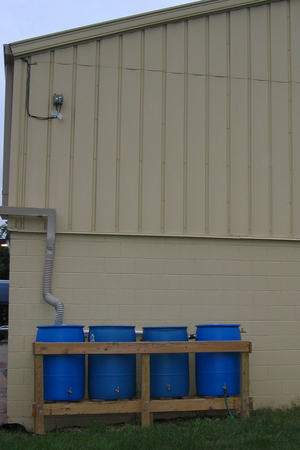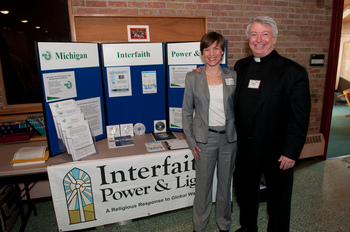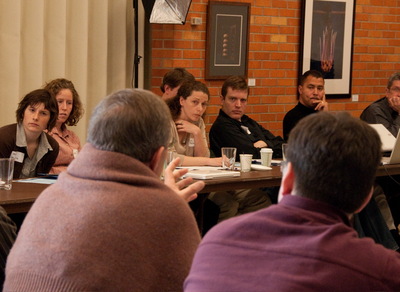Green religion: a movement with roots in Ann Arbor
As a Comparative Religion major at the University of Michigan, my studies often focus on sources of conflict between religions and resolution strategies. So it is rare and refreshing when I find an issue on which diverse faith-based organizations come together for a common purpose.
I stumbled upon such an issue recently while listening to the podcasts of National Public Radio - Faith Matters and Religion & Ethics Newsweekly, which focused on the reactions of religious organizations to the British Petroleum oil leak in the Gulf of Mexico.

The rain barrel system of the Vineyard Church is one way the Green Vineyard ministry is becoming more environmentally friendly.
Photo courtesy of Tricia Pietzyk
I had never thought it was a high priority in faith organizations to care for the environment and was therefore struck by how deep of a religious responsibility the churches located near the gulf felt toward the land.
It also made me wonder whether world religions could ever agree on the importance and responsibility we have toward the Earth.
I believe a dramatic green movement has emerged in the past decade. In part this is due to the world’s increasing interest in global warming and a recognition that much of the conflict in the world is due to energy needs. This encourages us to become "green" through energy efficiency, renewability and general conservation.
However, when approaching the idea of environmental stewardship from a religious perspective, we must ask whether or not our faith calls us to be "green" — and if so, how?
Individuals and organizations involved in green religion are not only environmentally aware for the common good and future of the Earth, but their environmental stewardship is motivated by a sense of higher responsibility to care for something that is not ours. It can be a form of worship toward something greater.
The "Energy Fast to Sack Hunger Sack” held at St. Francis of Assisi Parish at 2250 E. Stadium Blvd. this past Lent embodies this sense of higher responsibility.
Lent, usually a time for Catholics to sacrifice a luxury in their lives, took on the theme of an "energy fast" for the parish. Members were encouraged to replace all or at least one light bulb in their home with a more energy efficient light bulb during Lent. Money saved on members' utility bills was collected and donated to Food Gatherers on Easter.
The Energy Fast raised more than $9,000 from 179 participants.
Julie Lyons Bricker, executive director of Michigan Interfaith Power & Light (IPL) believes the idea of green religion is effective and particularly productive because religious communities offer a pre-existing group of people who typically already believe in stewardship and social justice.

Julie Lyons Bricker, LEED AP executive director, and Fr. Charles Morris, M. Div. Public Policy, public relations director.
Photo by flickr user TogetherGreen
Thus, faith organizations are in a unique position to capture people’s attention on such issues.
Green religion is promoted in Ann Arbor by organizations such as IPL, which is a national organization that works with religious congregations on issues of environmental stewardship. Since its founding in 1998, IPL has promoted the growth of green religion by gathering more than 10,000 congregations as members. Michigan, the fourth state to join IPL, added 25 congregations in July.
Six of these congregations are in Ann Arbor: Beth Israel Congregation, First Unitarian Universalist Congregation, Genesis of Ann Arbor, St. Francis of Assisi Parish, University of Michigan Hillel and the Vineyard Church.
One of the ways IPL encourages action within religious organizations is through project demonstrations. Last July, IPL gave away 1,400 compact fluorescent lamp (CFL) light bulbs to more than a dozen member congregations throughout Michigan. If each bulb is used for at least 3 hours a day, the project funded the equivalent of removing 102 cars from the road for one year or planting 145 acres of forest, said Lyons Bricker.
Through this demonstration, IPL showed how just a simple step, multiplied by the size of a religious congregation, can produce such effective results.
The need for environmental stewardship "isn't going away and Christians are more and more realizing that this has been a neglected issue" said Don Bromley, the executive pastor at the Vineyard Church of Ann Arbor. The Vineyard church supports one of the most active green religion ministries in Ann Arbor, Green Vineyard.
Since its founding in 2007, Green Vineyard has influenced the church to become a member of IPL and prompted large scale remodeling projects such as the implementation of a rain barrel system to collect runoff water for reuse, re-insulating the church’s roof to conserve heat and installing a dishwasher to reduce use of disposable kitchen products.
However, one of Green Vineyard’s most important programs is community education about environmental stewardship. Ken Wilson, senior pastor of the Vineyard church, is a founding member of the Friendship Collaborative, a community of congregations that works to combine the efforts and knowledge of scientists and faith leaders to benefit the environment.
According to its website, Friendship Collaborative holds workshops on college and university campuses nationwide for students, professors and members of faith communities to “establish personal contact between members from each community in the context of a shared concern to address the global environmental crisis.”
At a Friendship Collaborative workshop held on March 20, 2009 in Ann Arbor, Wilson said it was his personal belief that humans' overuse of energy "is God’s way of telling us we’ve been living beyond our means. We’re in this mess because we sacrificed the long-term good for short-term gain on an economic level.”

Faith leaders and scientists meet during a Friendship Collaborative workshop at the University of Michigan March 20, 2009.
Photo courtesy of Kirk Donaldson
"Scientists are not in a position to go around preaching about sacrifice because there’s no agreed-upon sacred text to advocate for sacrifice,” Wilson said. As a religious organization, “we’ve got a text that people regard as sacred, so it’s our job to start advocating for these things within our faith communities."
During my exploration of green religion in Ann Arbor, I have found an exciting and increasing sense of environmental stewardship in local religious organizations. Many religions are concluding that their faith does indeed call them to be ‘green’.
“The world belongs to God and we are placed here as caretakers,” the Rev. Rolf Bouma, a member of the faculty in University of Michigan’s Program in the Environment and Director of the Center of Faith and Scholarship, told me. “It is a very serious wrong to pollute it but it is also a great act of service to preserve it.”
While this act of preservation is not yet an accepted priority in all houses of faith, I have realized they do agree that pollution and inefficient energy consumption should be prevented. More and more congregations are also realizing that they have a unique ability to effect change on a large scale through their faith based mentality and large group of members.
I believe with the growing effectiveness of groups such as Friendship Collaborative and Interfaith Power and Light it is possible to unite religions on behalf of the Earth.
Katherine Axelsen is a summer intern with the Community team at AnnArbor.com.


Comments
Brent Lofgren
Mon, Aug 30, 2010 : 8:48 a.m.
I think that small steps by religious organizations, with education as part of the process, can multiply themselves through the members of that faith group. People have taken a long time, though, to learn the bad habits that they have--I don't think that wastefulness is the natural state of being--so it might take some time to learn more green modes of behavior. The sooner you get started, though, the sooner each step will happen. Although I don't have all the numbers handy, Scott is right about animal production being a major contributor to greenhouse warming; a big piece of that contribution is methane gas (CH4) from the digestive systems of cattle and sheep (also from some wild animals like deer, although they exist in much smaller numbers). CH4, although present in the atmosphere in much lower concentrations, is a much more potent greenhouse gas than is carbon dioxide (CO2).
ScottRNelson
Sun, Aug 29, 2010 : 9:47 p.m.
Seventh-day Adventists make a vital contribution to the green movement. The vegetarian diet is perhaps the single most important action people can take to improve upon the stewardship of the planet. SDAs are by definition vegetarian. It is estimated that 20% of green house gasses are produced by the animal products industry.